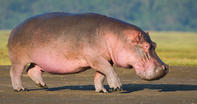
Name
Hippopotamus (Hippopotamus amphibius).Appearance
Hippos have unique skin. The fine epidermis renders the skin extremely sensitive to dehydration, up to seven times that of other mammals. For this reason, they while away the hottest hours of the day submerged in water without which, they would overheat.
If exposed to excessive heat and radiation the hippo will react firstly by secreting a red fluid from mucous glands on the skin, which is not blood, that acts as a sunscreen and thereafter the skin will dry and crack. In times of drought, hippos pack together in mud pools to remain hydrated. This leads to a great deal of conflict and they may then travel vast distances seeking permanent water.
Females have been observed dribbling saliva over exposed calves. A hippo’s eyes, nostrils and ears are situated high on its head and this enables the hippo to keep its heat-sensitive body submerged while all its vital senses are above the water to keep a lookout for trouble.
Hippos bask in the sun to warm themselves up, particularly during cooler times of the year. Hippo calves lose heat much quicker than the adults. If it is cold, a calf will lift itself onto its mother’s back to bask in the sun. By Megan Emmett
Hippo Diet
During the hot daytime in South Africa, the hippo sleeps in or around the riverbed. The hippo forages for food alongside the river at night when it is cooler.Hippo Breeding
In South Africa, a female hippo can produce up to ten calves during her lifespan of around 35 years. The cow gives birth to a single calf after a gestation period of 240 days. Female hippos hide their newborns in the nearby reeds for a few days, until the baby is ready to join the herd.
Females become sexually mature at the age of seven or eight years old. Many believe the hippo carries her young in the water, but what actually happens is that the small calf rests itself on its mother for warmth during colder weather conditions. This is because the baby hippo loses body heat faster than the adult hippo.
 The only other member of the hippo family is the rare pygmy hippopotamus (Choeropsis liberiensis) which is found in West Africa....
The only other member of the hippo family is the rare pygmy hippopotamus (Choeropsis liberiensis) which is found in West Africa.... Hippos practice a harem system where bulls occupy well-defended territories that contain nursery herds of females and their young....
Hippos practice a harem system where bulls occupy well-defended territories that contain nursery herds of females and their young.... Hippos are believed to be trying to cognitively recognize the deceased creature through the use of the chemo-sensitive Organ of Jacobsen loc...
Hippos are believed to be trying to cognitively recognize the deceased creature through the use of the chemo-sensitive Organ of Jacobsen loc... As they move, hippos create pathways through underwater vegetation, which is a valuable ecological service and is necessary to keep waterway...
As they move, hippos create pathways through underwater vegetation, which is a valuable ecological service and is necessary to keep waterway...